Hungarian actress, dancer and singer Rose Barsony (1909-1977) appeared in 16 films from 1929 to 1938, and in one more in 1957. The soubrette was a popular star of the operettas by Paul Abraham. She personified the idealised image of the spirited, happily dancing Hungarian in German and Austrian films, until the Nazis forbade the Jewish star to perform any longer.

German postcard by Ross Verlag, no. 6976/1, 1931-1932. Photo: Ufa.

Dutch postcard. Photo: Ufa. Publicity still for Walzerkrieg/The Battle of the Waltzes (Ludwig Berger, 1933).

German postcard by Ross Verlag, no. 192/4. Photo: Ufa. Publicity still for Walzerkrieg (Ludwig Berger, 1933) with Rose Barsony and Willy Fritsch.

German postcard by Ross Verlag, no. 6567/1, 1931-1932. Photo: Atelier Schneider, Berlin. Collection: Didier Hanson.
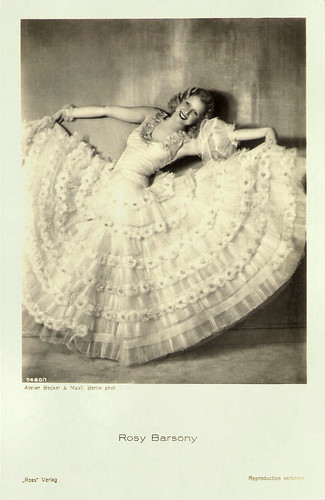
German postcard by Ross Verlag, no. 7480/1, 1932-1933. Photo: Becker & Maass, Berlin.
Rose Barsony - also credited as Rosi Barsony, Rosy Barsony, Rozai Barsony, Rózsi Bársony and Bársony Rózsi - was born as Rose Schustek in Budapest, Hungary in 1909.
She already appeared as a child actress on the stage, but her real career began in 1931 in Berlin with Paul Abraham's operetta 'Viktoria und ihr Husar/Victoria and Her Hussar'. She appeared as a soubrette, a soprano role frequently found in comic operas or operettas; the soubrette usually possesses a flirtatious demeanor and street wise manner.
Another popular operetta by Paul Abraham in which she starred was 'Die Blume von Hawaii/The Flower of Hawaii'.
In 1929 she had made her film debut in her home country with the silent film Mária növér/Sister Mary (Antal Forgács, 1929) starring Werner Pittschau, but especially her German film musicals of the 1930s would enjoy great popularity.
To these films belong Ein toller Einfall/A Mad Idea (Kurt Gerron, 1932), Walzerkrieg/The Battle of the Waltzes (Ludwig Berger, 1933) and the operetta Ball im Savoy/Ball at the Savoy (Steve Sekely, 1935) with Gitta Alpár.
Among her other Hungarian films were A ven gazember/The Old Scoundrel (Heinz Hille, 1932) and the comedy Helyet az öregeknek/Room for the Aged (Béla Gaál, 1934) with Szöke Sakall and Ernö Verebes.

Hungarian postcard by Globus, Budapest. Photo: Angelo Photos.

Small German collectors card in the 'Der künstlerische Tanz' series by Eckstein-Halpaus, Dresden, group 12 (Tanz-Artistik), no. 252. Photo: Alex Binder.
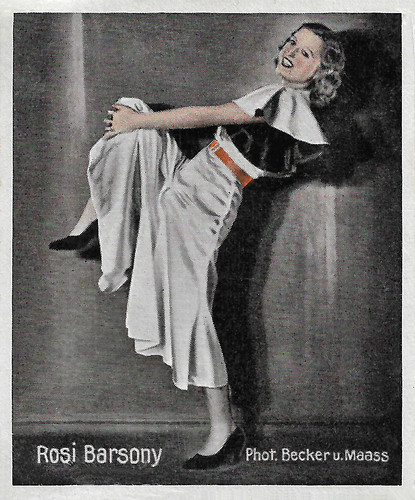
Small German collectors card by Eckstein, Dresden. Photo: Becker und Maass.
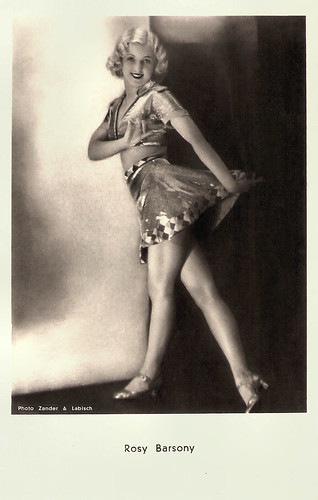
Austrian postcard Iris Verlag, no. 6586. Photo: Zander & Labisch.

Vintage postcard, no. 3928. Photo: Zander & Labisch.
After the assumption of power of the National Socialists, Rose Barsony got a special approval to work for the Ufa because of her Jewish origin. From 1935 this special arrangement stopped, and Barsony had to leave Germany.
She went on tour with her husband and stage partner, operatta singer Oszkár Dénes. They performed in Romania, Great Britain and the United States. They went to live and work in Italy, but in 1937 the fascist authorities forbade a Milan production of the operetta 'Zizì' with Barsony and her husband because they were Jewish.
During that period she still could appear in the Hungarian films Viki (Márton Keleti, 1937), 3:1 a szerelem javára/3 to 1 for Love (Johann von Vásáry, 1938) - a film adaptation of the Paul Abraham operetta 'Die Entführte Braut/The Kidnapped Bride', and A harapós férj/Biting Husband (Márton Keleti, 1938).
During the war years, Barsony lived in Budapest and because of an Auftrittsverbot she couldn't perform. New Hungarian stars like Marika Rökk followed in her footsteps and now personified the idealised image of the spirited, happily dancing Hungarian in German and Austrian films.
After the war her work was concentrated on the stage, and she worked in Romania and Italy. In 1956 she moved to Vienna to appear in several stage plays and operettas. She only returned on the screen once with Scherben bringen Glück/Seven Years Hard Luck (Ernst Marischka, 1957) starring Adrian Hoven. In 1959 she played at the Stadttheater Klagenfurt, Austria, and later she worked in Paris for French television.
Rose Barsony died in 1977 in Wien (Vienna), Austria. She was 67.
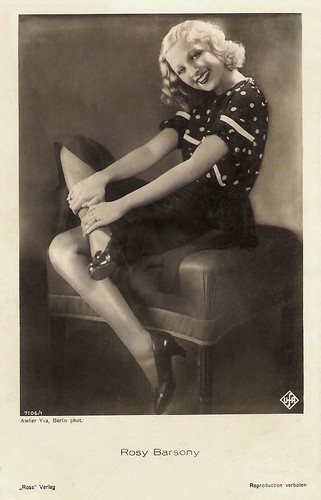
German postcard by Ross Verlag, no. 7106/1, 1932-1933. Photo: Atelier Yva, Berlin / Ufa.
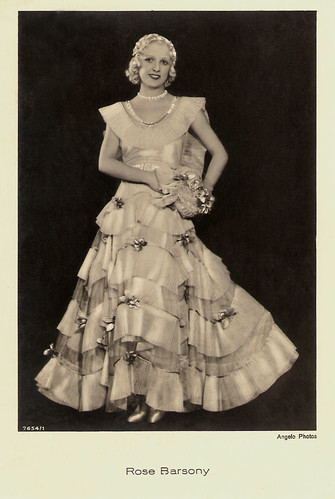
German postcard by Ross Verlag, no. 7654/1, 1932-1933. Photo: Angelo Photos.

German postcard by Ross Verlag, no. 7834/1, 1932-1933. Photo: Ufa.

German postcard by Ross Verlag, nr. 8005/1, 1933-1934. Photo: Ufa. Publicity still for Liebe muss verstanden sein/Love Must Be Understood (Hans Steinhoff, 1933).

German postcard by Ross Verlag, no. 8005/2, 1933-1934. Photo: Ufa.

German postcard by Ross Verlag, no. 8235/1, 1933-1934. Photo: Ufa. A publicity still from Walzerkrieg/Waltz War (Ludwig Berger, 1933).
Sources: Thomas Staedeli (Cyranos), Rudi Polt (IMDb), Allure, Wikipedia (German), and IMDb.

German postcard by Ross Verlag, no. 6976/1, 1931-1932. Photo: Ufa.

Dutch postcard. Photo: Ufa. Publicity still for Walzerkrieg/The Battle of the Waltzes (Ludwig Berger, 1933).

German postcard by Ross Verlag, no. 192/4. Photo: Ufa. Publicity still for Walzerkrieg (Ludwig Berger, 1933) with Rose Barsony and Willy Fritsch.

German postcard by Ross Verlag, no. 6567/1, 1931-1932. Photo: Atelier Schneider, Berlin. Collection: Didier Hanson.

German postcard by Ross Verlag, no. 7480/1, 1932-1933. Photo: Becker & Maass, Berlin.
Soubrette
Rose Barsony - also credited as Rosi Barsony, Rosy Barsony, Rozai Barsony, Rózsi Bársony and Bársony Rózsi - was born as Rose Schustek in Budapest, Hungary in 1909.
She already appeared as a child actress on the stage, but her real career began in 1931 in Berlin with Paul Abraham's operetta 'Viktoria und ihr Husar/Victoria and Her Hussar'. She appeared as a soubrette, a soprano role frequently found in comic operas or operettas; the soubrette usually possesses a flirtatious demeanor and street wise manner.
Another popular operetta by Paul Abraham in which she starred was 'Die Blume von Hawaii/The Flower of Hawaii'.
In 1929 she had made her film debut in her home country with the silent film Mária növér/Sister Mary (Antal Forgács, 1929) starring Werner Pittschau, but especially her German film musicals of the 1930s would enjoy great popularity.
To these films belong Ein toller Einfall/A Mad Idea (Kurt Gerron, 1932), Walzerkrieg/The Battle of the Waltzes (Ludwig Berger, 1933) and the operetta Ball im Savoy/Ball at the Savoy (Steve Sekely, 1935) with Gitta Alpár.
Among her other Hungarian films were A ven gazember/The Old Scoundrel (Heinz Hille, 1932) and the comedy Helyet az öregeknek/Room for the Aged (Béla Gaál, 1934) with Szöke Sakall and Ernö Verebes.

Hungarian postcard by Globus, Budapest. Photo: Angelo Photos.

Small German collectors card in the 'Der künstlerische Tanz' series by Eckstein-Halpaus, Dresden, group 12 (Tanz-Artistik), no. 252. Photo: Alex Binder.

Small German collectors card by Eckstein, Dresden. Photo: Becker und Maass.

Austrian postcard Iris Verlag, no. 6586. Photo: Zander & Labisch.

Vintage postcard, no. 3928. Photo: Zander & Labisch.
Fascist Authorities
After the assumption of power of the National Socialists, Rose Barsony got a special approval to work for the Ufa because of her Jewish origin. From 1935 this special arrangement stopped, and Barsony had to leave Germany.
She went on tour with her husband and stage partner, operatta singer Oszkár Dénes. They performed in Romania, Great Britain and the United States. They went to live and work in Italy, but in 1937 the fascist authorities forbade a Milan production of the operetta 'Zizì' with Barsony and her husband because they were Jewish.
During that period she still could appear in the Hungarian films Viki (Márton Keleti, 1937), 3:1 a szerelem javára/3 to 1 for Love (Johann von Vásáry, 1938) - a film adaptation of the Paul Abraham operetta 'Die Entführte Braut/The Kidnapped Bride', and A harapós férj/Biting Husband (Márton Keleti, 1938).
During the war years, Barsony lived in Budapest and because of an Auftrittsverbot she couldn't perform. New Hungarian stars like Marika Rökk followed in her footsteps and now personified the idealised image of the spirited, happily dancing Hungarian in German and Austrian films.
After the war her work was concentrated on the stage, and she worked in Romania and Italy. In 1956 she moved to Vienna to appear in several stage plays and operettas. She only returned on the screen once with Scherben bringen Glück/Seven Years Hard Luck (Ernst Marischka, 1957) starring Adrian Hoven. In 1959 she played at the Stadttheater Klagenfurt, Austria, and later she worked in Paris for French television.
Rose Barsony died in 1977 in Wien (Vienna), Austria. She was 67.

German postcard by Ross Verlag, no. 7106/1, 1932-1933. Photo: Atelier Yva, Berlin / Ufa.

German postcard by Ross Verlag, no. 7654/1, 1932-1933. Photo: Angelo Photos.

German postcard by Ross Verlag, no. 7834/1, 1932-1933. Photo: Ufa.

German postcard by Ross Verlag, nr. 8005/1, 1933-1934. Photo: Ufa. Publicity still for Liebe muss verstanden sein/Love Must Be Understood (Hans Steinhoff, 1933).

German postcard by Ross Verlag, no. 8005/2, 1933-1934. Photo: Ufa.

German postcard by Ross Verlag, no. 8235/1, 1933-1934. Photo: Ufa. A publicity still from Walzerkrieg/Waltz War (Ludwig Berger, 1933).
Sources: Thomas Staedeli (Cyranos), Rudi Polt (IMDb), Allure, Wikipedia (German), and IMDb.
No comments:
Post a Comment